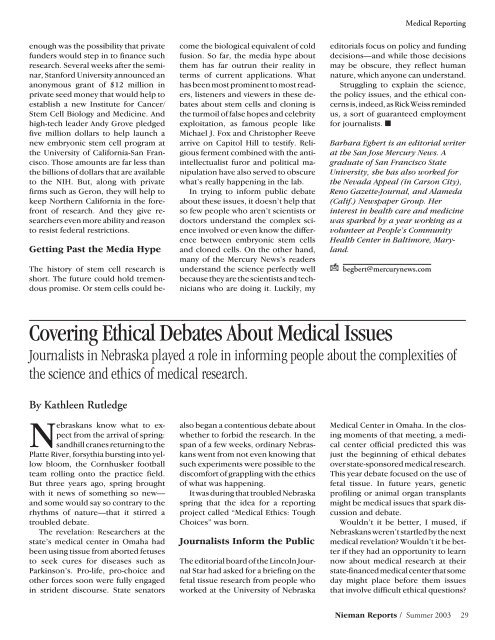summer-2003-Part 2-live - Nieman Foundation - Harvard University
summer-2003-Part 2-live - Nieman Foundation - Harvard University
summer-2003-Part 2-live - Nieman Foundation - Harvard University
- No tags were found...
Create successful ePaper yourself
Turn your PDF publications into a flip-book with our unique Google optimized e-Paper software.
Medical Reportingenough was the possibility that privatefunders would step in to finance suchresearch. Several weeks after the seminar,Stanford <strong>University</strong> announced ananonymous grant of $12 million inprivate seed money that would help toestablish a new Institute for Cancer/Stem Cell Biology and Medicine. Andhigh-tech leader Andy Grove pledgedfive million dollars to help launch anew embryonic stem cell program atthe <strong>University</strong> of California-San Francisco.Those amounts are far less thanthe billions of dollars that are availableto the NIH. But, along with privatefirms such as Geron, they will help tokeep Northern California in the forefrontof research. And they give researcherseven more ability and reasonto resist federal restrictions.Getting Past the Media HypeThe history of stem cell research isshort. The future could hold tremendouspromise. Or stem cells could becomethe biological equivalent of coldfusion. So far, the media hype aboutthem has far outrun their reality interms of current applications. Whathas been most prominent to most readers,listeners and viewers in these debatesabout stem cells and cloning isthe turmoil of false hopes and celebrityexploitation, as famous people likeMichael J. Fox and Christopher Reevearrive on Capitol Hill to testify. Religiousferment combined with the antiintellectualistfuror and political manipulationhave also served to obscurewhat’s really happening in the lab.In trying to inform public debateabout these issues, it doesn’t help thatso few people who aren’t scientists ordoctors understand the complex scienceinvolved or even know the differencebetween embryonic stem cellsand cloned cells. On the other hand,many of the Mercury News’s readersunderstand the science perfectly wellbecause they are the scientists and technicianswho are doing it. Luckily, myeditorials focus on policy and fundingdecisions—and while those decisionsmay be obscure, they reflect humannature, which anyone can understand.Struggling to explain the science,the policy issues, and the ethical concernsis, indeed, as Rick Weiss remindedus, a sort of guaranteed employmentfor journalists. ■Barbara Egbert is an editorial writerat the San Jose Mercury News. Agraduate of San Francisco State<strong>University</strong>, she has also worked forthe Nevada Appeal (in Carson City),Reno Gazette-Journal, and Alameda(Calif.) Newspaper Group. Herinterest in health care and medicinewas sparked by a year working as avolunteer at People’s CommunityHealth Center in Baltimore, Maryland.begbert@mercurynews.comCovering Ethical Debates About Medical IssuesJournalists in Nebraska played a role in informing people about the complexities ofthe science and ethics of medical research.By Kathleen RutledgeNebraskans know what to expectfrom the arrival of spring:sandhill cranes returning to thePlatte River, forsythia bursting into yellowbloom, the Cornhusker footballteam rolling onto the practice field.But three years ago, spring broughtwith it news of something so new—and some would say so contrary to therhythms of nature—that it stirred atroubled debate.The revelation: Researchers at thestate’s medical center in Omaha hadbeen using tissue from aborted fetusesto seek cures for diseases such asParkinson’s. Pro-life, pro-choice andother forces soon were fully engagedin strident discourse. State senatorsalso began a contentious debate aboutwhether to forbid the research. In thespan of a few weeks, ordinary Nebraskanswent from not even knowing thatsuch experiments were possible to thediscomfort of grappling with the ethicsof what was happening.It was during that troubled Nebraskaspring that the idea for a reportingproject called “Medical Ethics: ToughChoices” was born.Journalists Inform the PublicThe editorial board of the Lincoln JournalStar had asked for a briefing on thefetal tissue research from people whoworked at the <strong>University</strong> of NebraskaMedical Center in Omaha. In the closingmoments of that meeting, a medicalcenter official predicted this wasjust the beginning of ethical debatesover state-sponsored medical research.This year debate focused on the use offetal tissue. In future years, geneticprofiling or animal organ transplantsmight be medical issues that spark discussionand debate.Wouldn’t it be better, I mused, ifNebraskans weren’t startled by the nextmedical revelation? Wouldn’t it be betterif they had an opportunity to learnnow about medical research at theirstate-financed medical center that someday might place before them issuesthat involve difficult ethical questions?<strong>Nieman</strong> Reports / Summer <strong>2003</strong> 29
















